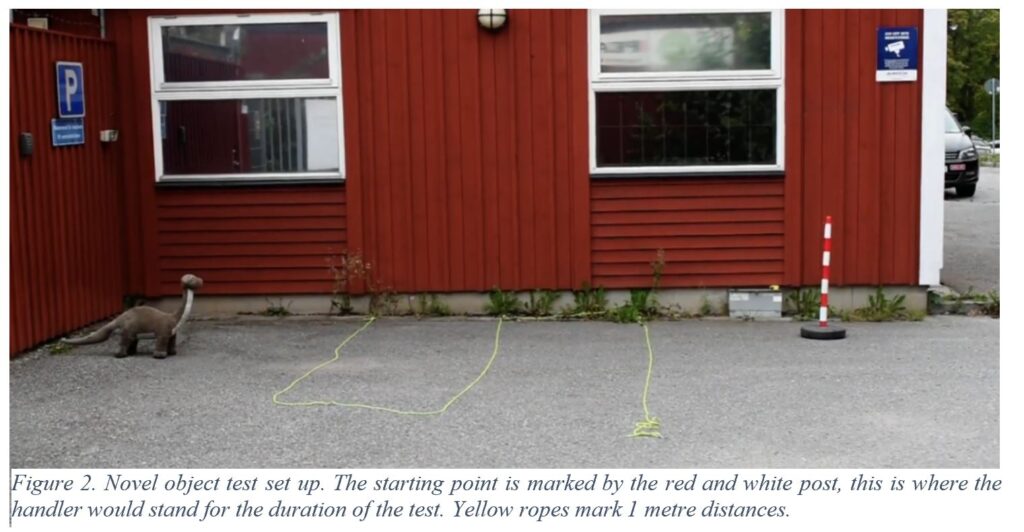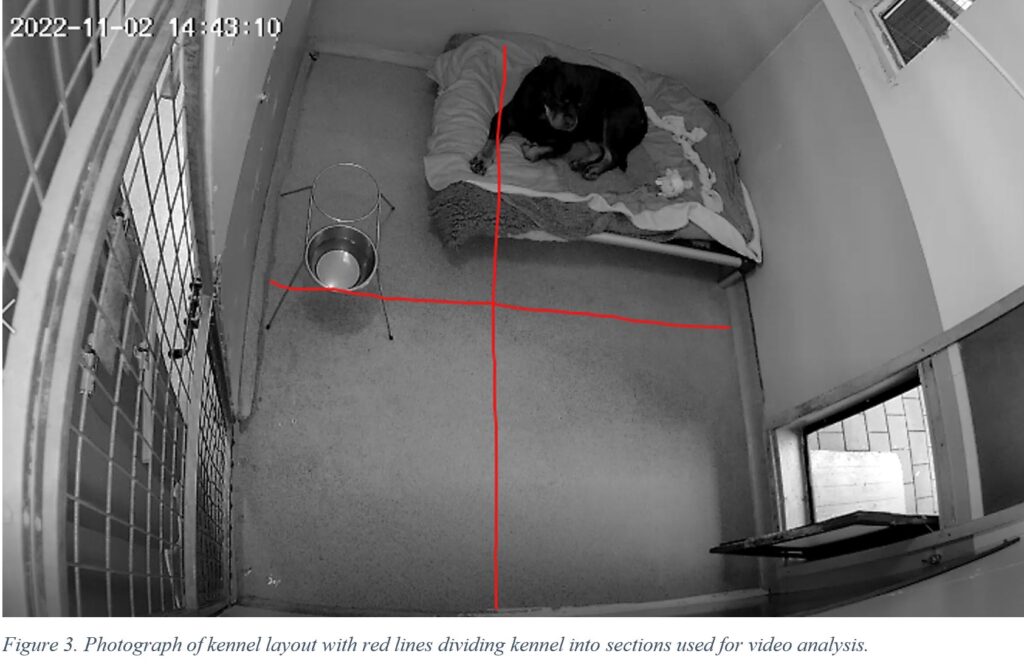Facilities & Subjects
This study was carried out at Hundstallet Dog Shelter in Stockholm between September and November 2022.
The shelter has multiple corridors of kennels where dogs are kept individually. Two of these corridors were used for the study. One housed the control group (control corridor) and the other housed the treatment group (treatment corridor). Dogs who were not taking part in the study were also present in both the control and treatment corridors.
Each individual kennel consisted of an indoor area measuring 2 x 2.3 meters, and an outdoor area measuring either 6 x 2.3 meters or 3 x 2.3 meters. The dogs were free to move between the indoor and outdoor area during the day. There was a raised bed with blankets both indoors and outdoors in each kennel, as well as a bowl of water and an assortment of toys.
This study involved 25 dogs in total, 13 males and 12 females, aged between 0.6 years and 13.5 years (mean age: 4.2 years). Staff at the shelter placed the dogs in the kennels they occupied for the duration of the study randomly, without knowledge of which corridor would be the treatment corridor.
Kennel Behaviour
To avoid any influence that the presence of a human observer could have on the dogs’ behaviour, video cameras were installed in each of the kennels to record the behaviour of the dogs in their kennels throughout the experiment. The audiobook used was a “Barnen I Bullerbyn”, a children’s book by Astrid Lindgren. The language of the audiobook was Swedish. It was played through Bluetooth speakers in the treatment corridor only.
The experiment itself occurred over a period of eight days. For the first two days the dogs’ routine remained the same as usual so that the baseline behaviour of the dogs could be recorded. For the following four days the audiobook was played in the treatment corridor every day on a loop between 9:00 and 17:00, while the control corridor remained unchanged. For the final two days neither corridor was exposed to the audiobook (Figure 1). This eight-day process was carried out twice, each trial included a control group (first trial: n=6, second trial n=5) and a treatment group (first trial: n=8, second trial: n=6). This second trial was conducted with new dogs that had not been part of the previous control or treatment groups and had not been exposed to the audiobook. There was a gap of 27 days between the first trial and the second trial.

Novel Object Test “Jurassic Bark”
The novel object test was carried out once with each dog participating in the study and occurred at the beginning of their daily morning walk.
The novel object was a large stuffed dinosaur. The test was conducted outside in a quiet area alongside the main Hundstallet building and was set up as portrayed in Figure 2. The distance between the object and the dog’s starting point was four metres and rope placed on the ground was used to mark each metre between the starting point and the novel object to measure the dog’s approach.

The handler would bring the dog out of the building keeping a short leash and wait at a designated spot out of sight of the novel object until they were told to proceed. Once the experimenter was ready, they would silently signal to the handler at which point the handler would walk with the dog around the corner to the test area and stop at a second marked point. As soon as they reached this point the handler would let the long leash to go slack and would allow the dog to move around the test area while the handler remained still at the marked point and avoided any interaction, physical or vocal, with the dog. The dog was allowed 30 s to explore the test area with the novel object in it. Once 30 s was up the experimenter silently signalled to the handler once again at which point the hander would call the dog’s name and then leave the test area, marking the end of the test session.
Data Analysis
For data analysis of the dogs’ behaviour in their kennels, each day was considered to have two parts, morning (9:00-13:00) and afternoon (13:00-17:00). For each dog, a specific 15-minute interval from each of these parts, morning and afternoon, was randomly selected for analysis. The same specific 15-minute intervals that were selected for each individual treatment dog were used for that dog every day throughout the study, to allow for as accurate a comparison as possible of the dog’s behaviour between the different days.
When analysing the videos, each kennel was considered to have five sections, one being the outdoor area which was out of sight. The rectangular indoor area was divided into quarters (Figure 3). For each of the 15-minute intervals, the total amount of time a dog spent in each of these sections of the kennel was observed and recorded as percentages of total time observed.

For the kennel behaviour percentage data, a generalized linear model with a gamma-log link function was used to investigate any effects of Group, Period, Batch and interaction between Group and Period. For the novel object test, the amount of time that the dog spent facing the object, sniffing the object and interacting with the object i.e., biting, pawing was recorded as well as the amount of time each dog spent within 3 metres of the object, within 1 metre of the object, and the latency of response when their name was called by the handler. Mann-Whitney U tests were used to compare novel object behaviour of the treatment and control groups and also to compare the results of the two different batches of dogs.